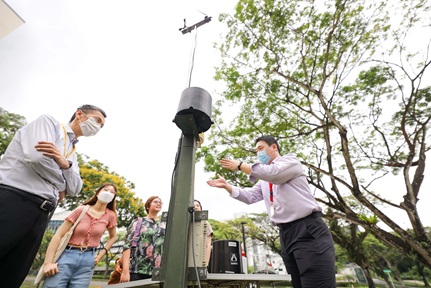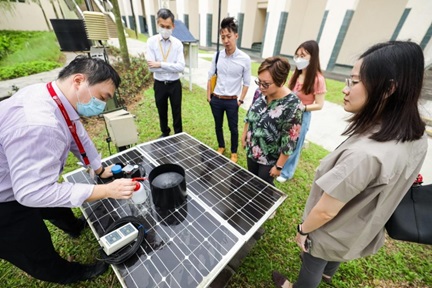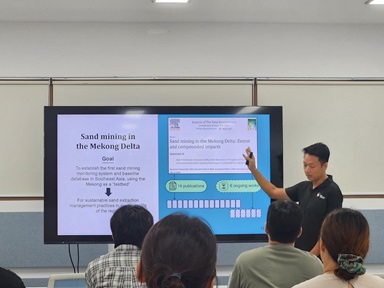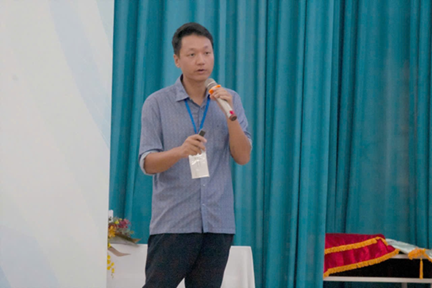Riverbed Sand Mining threatens the future stability of the Vietnamese Mekong Delta
River deltas are formed by the continual deposition of sediment over time. Sand is a major component of this sediment and is in high demand by the construction industry. Mining river sand is an important source of revenue to many developing countries, but what happens when the extraction of this resource begins to eat away the very delta itself. The Vietnamese Mekong Delta supports millions of people but, after decades of sand mining, is experiencing significant degradation from the activity. Here, Rachel Lau and Edward Park explain the challenges of sand mining and how it should be managed.
Though abundant in appearance, the scarcity of sand is often underestimated.
Today, rapid population growth and urbanization has made sand one of the highest consumed natural resources in the world. In particular, the demand for riverine sand, due to its unique shape and quality ideal for construction, has placed immense pressure on many of the world’s large river systems.
Sand and the Delta
Along the river channels of the Vietnamese Mekong Delta, the third largest delta in the world, sand mining activities have grown significantly since the early 1990s. Located at the southern tip of the Mekong River in Southeast Asia and home to around 20 million people, the natural depositional environment of the delta has historically ensured a rich sand supply to the region. Not only has this created one of the most fertile agricultural lands in Southeast Asia, but it has also provided the country, and developing neighbouring economies, with the necessary resources for new buildings and infrastructure. The high demand for sand has made the region a global hotspot for sand mining.
In the Vietnamese Mekong Delta, barges with crane are most commonly used to mine sand from the riverbed (Figure 1). A visit to the delta year-round, particularly in the upper reaches of the major rivers, Hau (Bassac) and Tien (Mekong), would present a scene with dozens of sand mining boats along the river channels, the clanking of cranes used for sand excavation echoing distances away.
The costs of excavation
Unfortunately, such heavy excavation does not come without a cost. From changes in the riverine geomorphology and hydrologic properties, reduced ecological productivity, and worsened social vulnerability, the effect of sand mining on the surrounding environment are increasingly being studied and documented. Amongst these impacts, sediment losses and morphological changes to the riverbed are the most direct and apparent. Between 2017 and 2022, extensive bathymetry survey across 800 km2 of the river channels revealed an average reduction in elevation of 1.3 – 1.4 m across the upper reaches of the Vietnamese Mekong Delta. This equates to more than 100 million cubic metres of sediment losses across each of the river’s upper reaches.
While these reductions could also have been attributed to sediment trapped in upstream dams, the contribution of sand mining activities is clear from the detailed spatiotemporal analysis of individual longitudinal and cross-sectional profiles of riverbed elevation. Many of these elevation profiles reflected localized deep pockmarks (>10 m deep) unique to sand mining operations, which also varied across different years based on shifting mining activities. Local hotspots were further identified as regions around major cities including Can Tho, Long Xuyen, Sa Dec and Tan Chau.
For the low-lying delta of the Mekong, large reductions in elevation and losses of sediment could have severe cascading consequences on the entire deltaic system (Park et al, 2022). Of significant concern is the increasing rates of riverbank erosion and collapse. Observations from field surveys have shown there is a close proximity of riverbank erosion to the pitted riverbeds unique to sand mining activities. This is compelling evidence of their association. The pits formed after sand excavation have to undergo adjustment to reestablish equilibrium. Although sediment deposition can partially refill these pits, local sediment redistribution remains the primary mechanism due to severe sediment depletion in the delta over recent years. As time progresses, this process leads to steepened bed slopes and broader river channels, ultimately undermining the stability of the riverbanks.
As a result, losses of homes and properties along riverbanks are increasingly widespread in the delta (Tran et al, 2023). Most recently, journalist Tuyen (2022) highlighted that a staggering 1,808 houses were reported to have collapsed between 2018 and 2020, concentrated in regions with highest volumes of river sand extraction. However, to accurately determine the relative contribution of sand mining to these incidences necessitate further research, analysis and modelling efforts.
With the current trajectory of intensifying riverbed sand mining in the region, compounded by other factors such as sea level rise, shifts in tropical cyclone activities, groundwater extraction and upstream dams, it can only be expected that this region will experience more severe environmental and social repercussions.
The way forward
Yet, recognizing the vital role of the sand mining industry and sand trade in the region’s economy and the livelihoods of its residents, an outright ban on this activity is not a practical solution. Instead, it is necessary for a comprehensive management framework that incorporates:
(1) Accurate quantification of sand mining activities through development of an affordable remote-sensing-based monitoring system that can estimate sand mining budgets based on sand mining boats detection (Gruel et al, 2022). This reduces reliance on traditional field surveys, though critical in providing baseline information, are often time-consuming and resource intensive. Additionally, it also allows for detection of illegal sand mining activities, prevalent in the Vietnamese Mekong Delta, facilitating enforcement actions.
(2) Assessment of relative contribution of sand mining to riverbank erosion in the context of other anthropogenic and natural pressures in the delta, through hydrodynamic modelling. This enables informed environmental impact assessment and implementation of appropriate mitigation strategies to protect the riverbanks and locals’ livelihoods.
(3) Identification of sustainable sand harvesting sites where sand extraction can be carried out without exceeding replenishment rates.
Without a comprehensive regulatory framework to guide sustainable management of sand resources in the delta, its long-term stability remains questionable.
More information: Rachel Lau [email protected]
This story is a summary of the article
Lau RYS, E Park, DD Tran & J Wang (2023). Recent intensification of riverbed mining in the Mekong Delta revealed by extensive bathymetric surveying. Journal of Hydrology, 130174. https://doi.org/10.1016/j.jhydrol.2023.130174
Rachel Yu San Lau is a research assistant in NIE and the Tropical Rivers Group at EOS, NTU. Her research interests lie in various aspects of coastal and river geomorphology, spatiotemporal studies, geographic information systems, and environmental sustainability.
Edward Park is an Assistant Professor in Physical Geography at NIE and ASE (courtesy appointment), and a Principal Investigator (PI) at EOS, NTU, where he is developing a river research program entitled Tropical Rivers in the Anthropocene. His research attends to hydro-geomorphic processes and wetland hydro-sedimentary dynamics, which is strongly based on geospatial technologies, hydrological modelling, statistical methods and traditional fieldwork in geomorphology.
References
Gruel CR, E Park, AD Switzer, S Kumar, HL Ho, S Kantoush, D Van Binh & L Feng (2022). New systematically measured sand mining budget for the Mekong Delta reveals rising trends and significant volume underestimations. International Journal of Applied Earth Observation and Geoinformation, 108, 102736.
Park E, HH Loc, D Van Binh & S Kantoush (2022). The worst 2020 saline water intrusion disaster of the past century in the Mekong Delta: Impacts, causes, and management implications. Ambio, 51, 691–699.
Tran DD, ND Thien, KW Yuen, RYS Lau, J Wang & E Park (2023). Uncovering the lack of awareness of sand mining impacts on riverbank erosion among Mekong Delta residents: insights from a comprehensive survey. Scientific Reports, 13(1), 15937.
Tuyen D. (2022, September 1). In Vietnam’s Mekong Delta, sand mining means lost homes and fortunes. Eco-Business. Retrieved January 3, 2023, from https://www.eco-business.com/news/in-vietnams-mekong-delta-sand-mining-means-lost-homes-and-fortunes/
Read the original article here.







